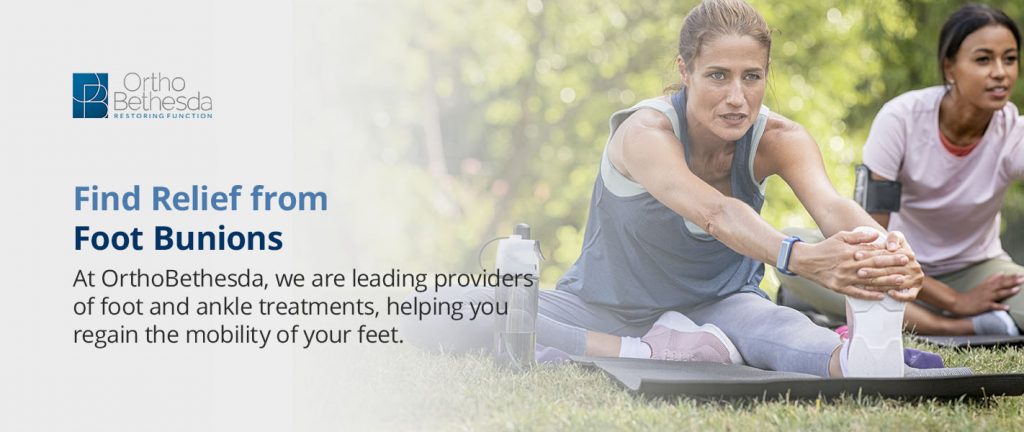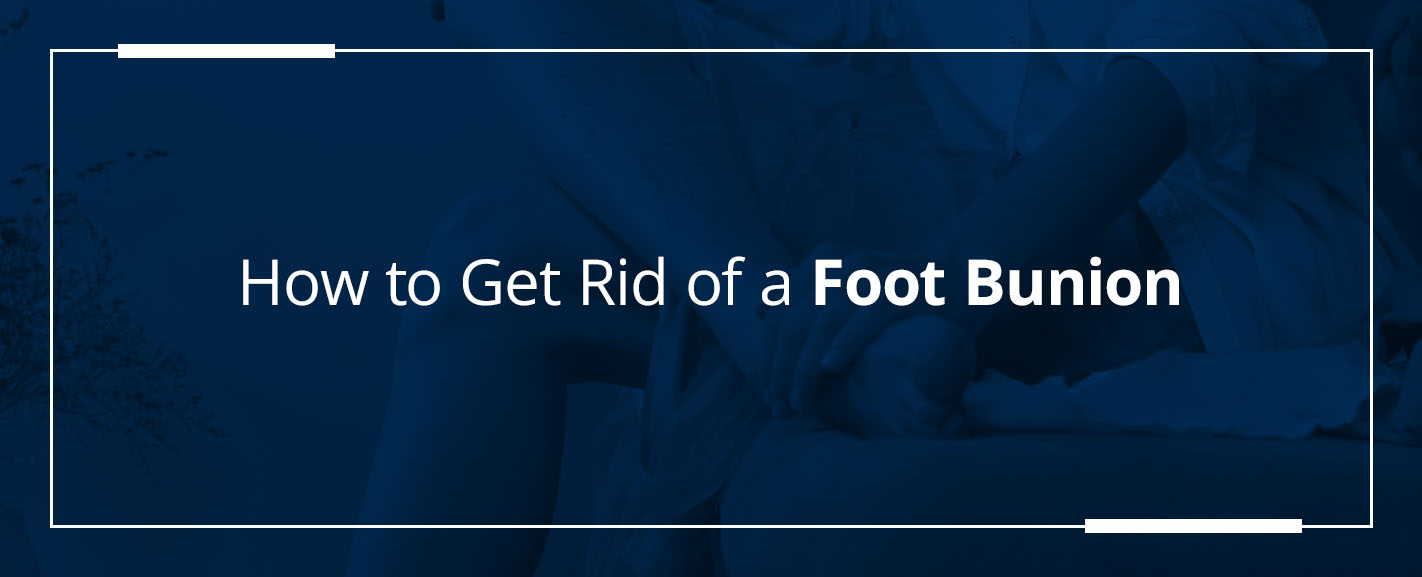
Living with bunions can be uncomfortable and make standing, walking and other daily activities painful. If you have bunions, you are likely looking for effective bunion pain relief so you can return to your daily responsibilities. Learn more about what causes bunions and how to find relief from discomfort, irritation and pain.
What Are Foot Bunions?
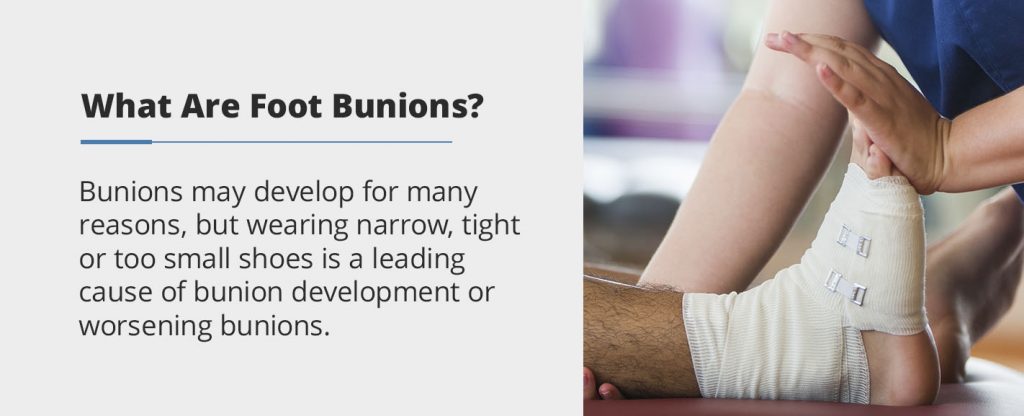
A bunion is a bony growth that develops on the joint at the big toe’s base and typically develops when bones in the front of the foot are moved out of place. Shifting bones can cause the top portion of the big toe to pull inward towards the other toes, causing the joint at the base of your big toe to protrude. The skin over a bunion is often inflamed, swollen and painful.
Bunions may develop for many reasons, but wearing narrow, tight or too small shoes is a leading cause of bunion development or worsening bunions. Bunions may develop due to a foot deformity, the shape of your foot or a medical condition, including arthritis. Small bunions, commonly referred to as bunionettes, also develop outside of the joint of the smallest toe.
What Causes Foot Bunions?
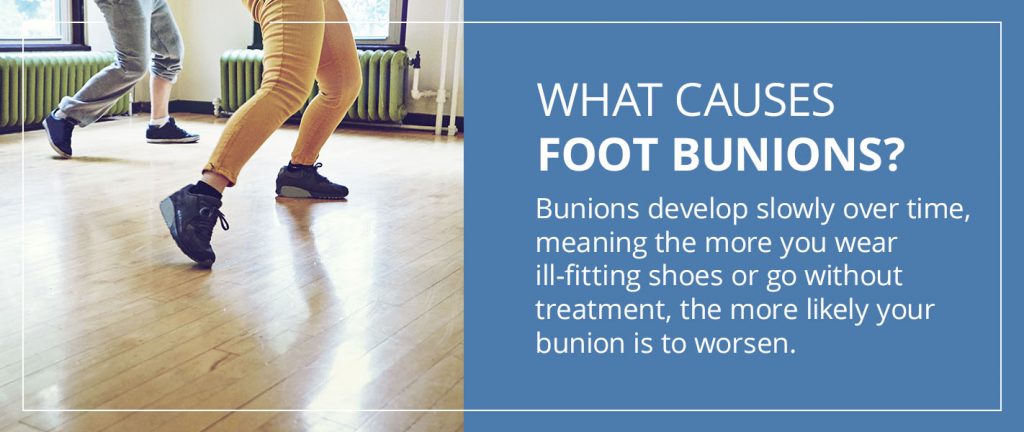
Bunions develop slowly over time, meaning the more you wear ill-fitting shoes or go without treatment, the more likely your bunion is to worsen. Over time, bunions cause the natural structure of the bone to change, resulting in the signature bump a bunion is known for. Without proper treatment or correction, this bump will worsen, making it difficult or painful to walk and wear shoes.
Research has found 23% of adults 18 to 65 experience bunions, and 36% of adults over 65 develop bunions. While anyone may develop a bunion, it is more common in women. Bunions have numerous causes and are often more common with old age. Some of the most common causes of bunions include:
- High heels: Wearing high heels can cause pressure on your toes, forcing them to the front of the shoe. Higher heels have even more severe effects than shorter heels, often causing bunions to develop.
- Rheumatoid arthritis: Many preexisting medical conditions can increase a person’s likelihood of developing bunions. One of the most common conditions that may make bunions more likely is rheumatoid arthritis.
- Poorly fitting shoes: The fit of your shoe plays an essential role in the health of your feet. Wearing too small or otherwise ill-fitting shoes can increase a person’s chance of developing bunions.
- Genetics: If you have a family history of bunions, you may be more likely to inherit a problem with the anatomy or structure of your feet.
- Injury: An acute foot injury can negatively impact the foot’s structure and increase the likelihood of developing bunions.
Symptoms of Foot Bunions
Each person is different and may experience varying bunion symptoms. Symptoms will vary depending on the severity and how long the bunion has been left untreated. Some of the most common symptoms of a foot bunion include:
- Bump: One of the most apparent symptoms of a bunion is a bump that forms on the side of the foot slightly below the big toe. Each toe is attached to a metatarsal bone within the foot. As a bunion forms, this bone becomes displaced, adding pressure to and enlarging the metatarsal, which causes the characteristic bump of a bunion to form.
- Pain: As bunions form slowly over time, years of abnormal pressure on the toes and foot paired with improperly fitting shoes can cause pain within the metatarsal and surrounding areas. Bunions are uncomfortable and, in severe cases, can cause excessive pain, making standing or walking difficult or even impossible.
- Numbness: Some people with bunions may also experience periodic tingling or numbness. Numbness is a common bunion symptom that can develop when sensitive nerves within the foot become compressed by the bones of the toes and foot. When compressed, nerves cannot function properly, causing a loss of sensation in the foot or toe.
- Difficulty walking: Severe bunions can disrupt daily life and decrease the overall quality of life. If someone has severe pain, nerve damage or swelling, wearing shoes can be difficult. Many patients may even have trouble walking or standing, negatively impacting their ability to perform daily tasks.
- Corns or calluses: As a bunion forms and a bump develops, there is increased pressure in this area of the foot, especially when wearing shoes or walking. Corns and calluses also form on the feet as a reaction to continued pressure. When a bunion rubs against the inside of a shoe, calluses and corns can form on the bunion.
At-Home Treatments for Foot Bunions
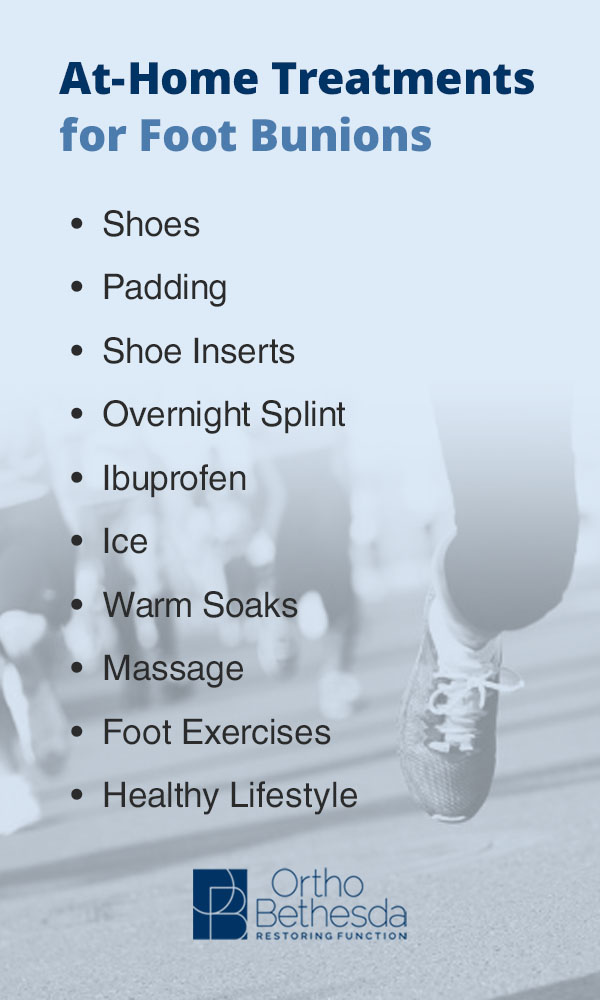
At-home treatments can be an effective solution without surgery that can alleviate pain and discomfort. While surgery is an effective treatment option for many patients, some may experience adequate bunion relief from nonsurgical treatments. In most cases, a physician will recommend nonsurgical treatments before recommending a patient undergo foot surgery for bunions.
1. Shoes
Shoes play a large role in the health of your feet and can contribute to the development of bunions. If you experience bunion pain, look at your footwear and see if your shoes may be worsening or even causing your problem. Ideally, you should only wear bunion-friendly footwear to reduce pain and discomfort, minimizing symptoms and preventing bunions from worsening.
Look at the shoe’s structure, paying close attention to its pressure points. Opting for footwear with mesh or stretch panels can help minimize the pressure placed on the foot and toes. Typically, it is best to avoid leather panels or those made out of restrictive material that may worsen binding.
2. Padding
Bunion pads can help temporarily relieve pain and discomfort from bunions by creating a protective barrier between a person’s shoe and bunion. Padding can improve bunion symptoms by preventing excess rubbing and irritation, which is often why many bunions develop. Bunion pads are best when combined with bunion-friendly shoes that are spacious enough not to cramp the toes and feet.
Bunion padding often comes in two forms, with the first being similar to a sock that covers most of the foot, protecting the side of the big toe where a bunion forms. Bunion padding may also be a small cushion you can place between the bunion and the inside of your shoe. Bunion pads often have an adhesive to keep the padding secure while standing or walking.
3. Shoe Inserts
Shoe inserts can also minimize the pain and discomfort associated with bunions. There are pre-made shoe inserts you can purchase at your local pharmacy to alleviate foot pain. You may also want to consider having custom orthotics created to fit your foot’s unique curvature and provide the most noticeable results. Custom orthotics can restore foot function and improve the alignment of the foot and toes.
Orthotics can also prevent bunions from worsening, minimizing the need for extensive surgery.
4. Overnight Splint
An overnight bunion splint wraps around your feet and helps to align your toes. You can wear these splints overnight and when you will not be wearing footwear. Although a splint will not cure a bunion, it can relieve various painful symptoms, including discomfort and inflammation. Splints help ensure proper alignment of the foot and toes to alleviate the pressure that causes and worsens bunions.
Because overnight splints help ensure healthy alignment within the foot and toes, they can temporarily improve the tingling or numbness from nerve pressure and improper alignment. Overnight bunion splints help stretch tendons and ligaments, promote proper alignment and improve or break apart areas of scar tissue.
5. Ibuprofen
Over-the-counter medicine, including ibuprofen, can help relieve pain from bunions. Joint disorders, such as bunions, commonly cause pain from excess inflammation, making anti-inflammatory medicine an effective treatment modality. Ibuprofen can minimize swelling, helping to alleviate pressure and tension that causes pain.
While the effects are temporary, ibuprofen can improve painful symptoms, especially when you may notice more pronounced or severe bunion symptoms.
6. Ice
Ice packs and cold compresses can also improve bunion symptoms, especially if you notice symptoms after a long day on your feet. Ice packs can reduce painful swelling and inflammation while relieving overall soreness. You may want to check with your physician before regularly applying ice packs if you have existing circulation problems or reduced feeling.
Regularly applying ice packs to a bunion can help control its size and prevent the bunion from worsening. Most patients only use ice packs when they notice swelling or discomfort, which may occur at the end of the day or after work.
7. Warm Soaks
A warm soak can benefit your feet and toes if you are experiencing bunion symptoms. If you spend a lot of your day on your feet or walking, you may want to consider regularly soaking your feet in warm water after the day. Warm soaks can improve painful bunion symptoms and alleviate tension, stress and general discomfort.
You can soak your feet in a special foot bath or fill your tub just enough to cover your feet. Adding a sprinkle of Epsom salt can make a warm soak even more relaxing and helpful. Soaking with Epsom salt can alleviate muscle pain and calm achy, sore joints.
8. Massage
A foot massage can promote relaxation and healing within the feet and toes. A massage can improve circulation within the foot while decreasing stiffness. One of the most beneficial aspects of a massage for bunions is reducing the overall amount of pain or discomfort you experience daily. A massage is even more effective when combined with other bunion treatment modalities.
A bunion has a trigger point, which can cause the muscles and ligaments to tense and shorten. A bunion massage can alleviate this strain and stretch out the surrounding muscles. At first, it may be normal to experience slight discomfort when beginning to massage. Be gentle to your feet, as they can be quite sensitive with bunions.
9. Foot Exercises
Since bunions form over time, daily and weekly habits play a significant role in the health of your feet. Physical therapy with simple at-home foot exercises is an excellent option to strengthen the feet and minimize painful bunion symptoms. Foot exercises and toe stretches can improve joint health and your foot’s mobility and range of motion.
Additionally, foot exercises help strengthen the foot muscles and maintain flexibility. You can perform many foot exercises to improve foot health, making these exercises easy to implement into your daily or weekly routine.
10. Healthy Lifestyle
While many people may not realize it, your diet can directly affect foot health and bunions. Many bunion symptoms result from excessive inflammation in the body, so you may want to consider following an anti-inflammatory diet that minimizes inflammatory foods, drinks and spices. Some of the most common things that cause excess inflammation include highly processed snack foods, sugary drinks and highly refined or bleached flour.
Surgical Treatment for Foot Bunions
Bunion surgery, also known as bunionectomy, is a specialized surgery designed to improve bunions and related bunion symptoms. If you are not experiencing relief from nonsurgical treatments, your physician may suggest bunion surgery to improve your symptoms and correct a bunion at its source.
When to Get Treatment
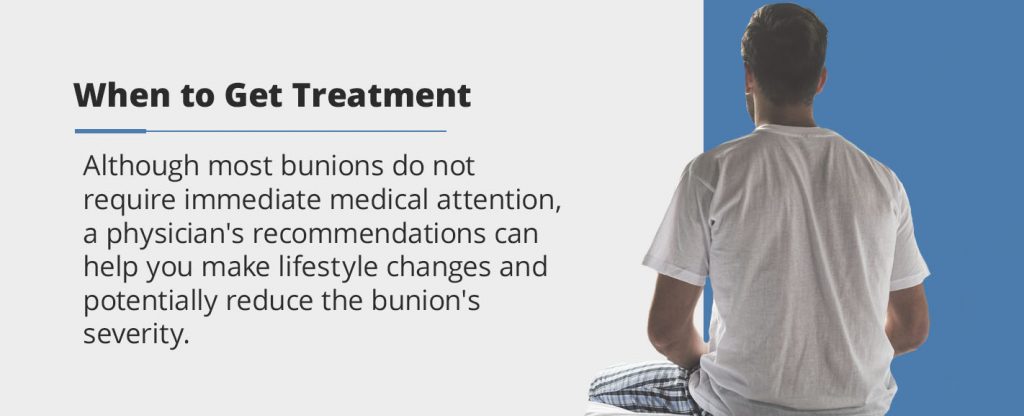
Because bunions develop and worsen over time, you may wonder when to see a doctor about your symptoms. Generally, early intervention is the most effective way to minimize the severity of a bunion and prevent it from worsening to a severe or larger stage. Although most bunions do not require immediate medical attention, a physician’s recommendations can help you make lifestyle changes and potentially reduce the bunion’s severity.
Patients who regularly experience severe pain or discomfort should consider scheduling an appointment with their doctor. Additionally, if a bunion negatively impacts your daily life or prevents you from walking, wearing shoes or performing essential tasks, you should see a physician for treatment suggestions. Professional bunion treatments can correct a painful bunion and help you regain the ability to stand, walk and perform daily tasks comfortably.
Another complication of a worsening bunion is the inability to find shoes that fit properly. As the bump of a bunion develops, it causes the foot to widen, which can lead to your shoes no longer fitting. If there is an overlap between your big toe and your second toe, this may also indicate you should seek medical attention. While these severe symptoms may be an obvious indicator you should see a doctor, some patients may only experience moderate symptoms.
A good rule of thumb for patients experiencing moderate bunion symptoms is to note how long these symptoms last. Keep track of whether the pain occurs daily, during certain actions or a few times a week. As you assess your symptoms, you may want to call a doctor if your symptoms worsen or do not improve after two to three weeks of at-home bunion remedies.
Types of Foot Bunion Surgery
If you do not experience relief with nonsurgical bunion treatments, you may want to consider bunion surgery. While nonsurgical bunion treatments help many patients experience relief, severe cases may only improve with surgical intervention. Some of the main types of foot bunion surgery include:
- Fusion: Bunion fusion surgery may be recommended to stop a bunion from worsening and easing tension within the toe’s joint. A bunion fusion may be performed on the big toe joint or where the metatarsal meets the middle of the foot. The location of fusion surgery will depend on where your bunion and painful symptoms originate.
- Cut and removal: A cut and removal bunion surgery is when part of the bone within the foot is removed. The size and location of the bone removed depends on the severity of your bunion symptoms. Removing portions of the bone lets your physician reposition the remaining bones in a healthier and more comfortable position. For more extreme bunions, a physician may need to remove the metatarsal head located at the bottom of the big toe. In most cases, a cut and removal procedure is a smaller surgery with a quicker recovery period and is often less expensive than more invasive or extensive bunion surgeries. Minor surgery can help reduce the need for more extensive surgery down the line.
- Joint implant: An artificial joint implant can replace a damaged or unhealthy joint within the foot that may be causing or worsening bunion symptoms. A bunion surgeon can remove bone spurs and small pieces of bone to make room for the new joint. Bunion joint replacement surgery may be recommended for patients experiencing arthritis symptoms within the feet and toes. A joint implant can reduce arthritis-related pain in the foot and improve the toe’s mobility. A surgeon will also have to correct any damages or misalignment in the foot and toes during a joint implant procedure.
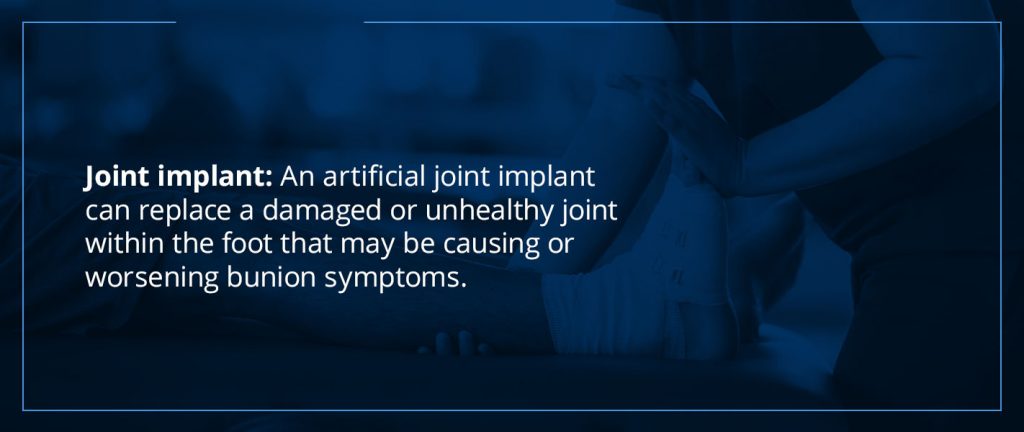
What to Expect From Treatment
The exact details of a bunion treatment vary from patient to patient and depend on the bunion treatment or surgery you may be undergoing. For bunion surgery, a minimum of one incision will be made to access the big toe joint. In some cases, a bunion surgeon may need to make two or more incisions to access the toe joint and correct a bunion.
Surgical time also varies depending on the technique and severity of your bunion symptoms and foot misalignment. In some cases, bunion surgery may take as little as 45 minutes. On the other hand, more complex bunion surgery may take up to three hours. Following bunion surgery, your bunion surgeon will close any incisions. You will then be moved to the recovery room. Most patients are ready to go home within one to two hours but need a friend or family member to drive for them.
Recovery From Foot Bunion Surgery
Following bunion surgery, patients may experience pain or discomfort as they recover, which can be improved with pain medication. Two weeks following your bunion surgery, your bunion surgeon will remove your stitches. It will take anywhere from six to 12 weeks for the bones of the foot to heal fully, and most patients will need to wear a protective boot while the foot continues to heal.
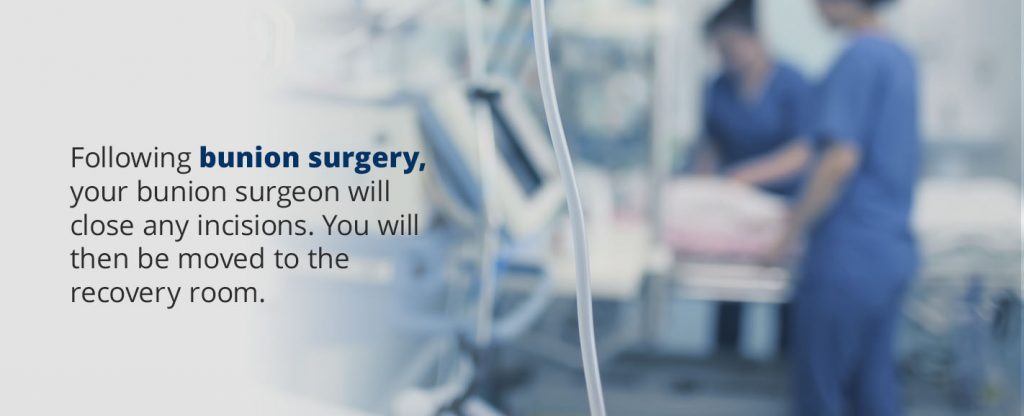
As your foot heals, you will not be able to put direct weight on it. Many patients will need to use crutches, a walker or even a scooter to move safely without causing strain on your healing foot. The amount of weight you can place on the foot and when depends on the bunion surgery you underwent.
Around the six to 12 week mark, you will begin regaining basic foot function. Your physician will recommend bunion physical therapy exercises to strengthen your foot and toes, improving mobility and range of motion. Most patients can resume their daily tasks and activities approximately three months after their surgery.
Common Problems From Foot Bunion Surgery
Although bunion surgery is a safe and effective treatment, there is a small potential for complications or side effects. Some of the most common bunion surgery complications include ineffectiveness to relieve pain or failure for the bone to heal fully. Some patients may also experience infection, big toe stiffness or nerve injury. Finally, while a bunion correction may initially improve symptoms, some patients experience bunion recurrence or a bunion developing again following treatment.
Fortunately, these bunion surgery complications are uncommon and can be treated effectively. When a trained bunion surgeon performs bunion surgery correctly, these risks are also greatly reduced. Before surgery, your physician will discuss and explain and potential complications or side effects. Your doctor will also provide post-operative instructions to minimize your risk of complications.
Find Relief from Foot Bunions
At OrthoBethesda, we are leading providers of foot and ankle treatments, helping you regain the mobility of your feet. We understand bunions can be extremely painful and uncomfortable, negatively impacting your daily life. We strive to provide the latest, most innovative treatments for our patients and provide superior patient care. Along with treating foot and ankle conditions, our team of experts can also address conditions affecting the elbow, knee, hip, shoulder, hands and wrists and spine.
To learn more about our bunion treatments and surgery, contact us online today or call (301) 804-1137.
